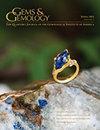自然色绿色钻石:美丽的Conundrum
IF 1.6
3区 地球科学
Q2 MINERALOGY
引用次数: 19
摘要
宝石因其美丽和稀有而受到重视。有趣的是,最稀有的钻石颜色通常与三种最受欢迎的颜色相关联——绿色、蓝色和粉红色到红色。自然界中产生结构缺陷(碳原子晶格中的缺陷;(见Shigley and Breeding, 2013)负责最具活力的绿色,蓝色和粉红色/红色钻石的色调是如此罕见,以至于许多人甚至不知道这些石头的存在。在过去的十年中,含有这些天然颜色成分的钻石在提交给GIA全球实验室的钻石中所占比例不到0.4%(包括彩钻和D-Z级钻石)。纯绿色、蓝色或红色的钻石更为罕见,在所有被检测的钻石中所占比例不到0.07%。在过去的20年里,许多发表在科学和宝石学文献上的文章都研究了彩色钻石的特定属性、质量分级特征或特殊处理方法。然而,很少有研究人员有机会研究大量类似颜色的天然钻石,并报告它们的独特特征。彩钻极为罕见,因此价值很高。这一价值因素意味着大多数有色介质都需要实验室报告本文章由计算机程序翻译,如有差异,请以英文原文为准。
Natural-Color Green Diamonds: A Beautiful Conundrum
valued of gemstones due to their beauty and rarity. Interestingly, the rarest of diamond colors correlate with the three most popular choices for favorite color, in general—green, blue, and pink to red. The unique set of conditions in nature that produce the structural imperfections (defects in the lattice of carbon atoms; see Shigley and Breeding, 2013) responsible for the most vibrant hues of green, blue, and pink/red diamonds are so uncommon that many people are not even aware these stones exist. Over the last ten years, diamonds with these natural color components comprised less than 0.4% of all diamonds submitted to GIA’s laboratories worldwide (including both fancy-color and those on the D–Z scale). Pure hues of green, blue, or red are even rarer, accounting for less than 0.07% of all diamonds examined. Many articles published over the last 20 years in the scientific and gemological literature have looked at specific properties of colored diamonds, quality grading characteristics, or particular treatments. Few researchers, however, have had the opportunity to examine large quantities of similarly colored natural diamonds and report on their distinctive characteristics. Colored diamonds are extremely rare and, consequently, highly valued. This value factor means that laboratory reports are requested for most colored dia-
求助全文
通过发布文献求助,成功后即可免费获取论文全文。
去求助
来源期刊

Gems & Gemology
地学-矿物学
CiteScore
2.90
自引率
19.20%
发文量
10
期刊介绍:
G&G publishes original articles on gem materials and research in gemology and related fields. Manuscript topics include, but are not limited to:
Laboratory or field research;
Comprehensive reviews of important topics in the field;
Synthetics, imitations, and treatments;
Trade issues;
Recent discoveries or developments in gemology and related fields (e.g., new instruments or identification techniques, gem minerals for the collector, and lapidary techniques);
Descriptions of notable gem materials and localities;
Jewelry manufacturing arts, historical jewelry, and museum exhibits.
 求助内容:
求助内容: 应助结果提醒方式:
应助结果提醒方式:


